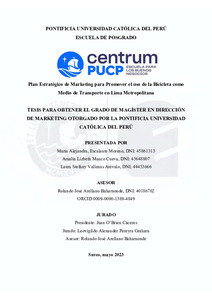| dc.contributor.advisor | Arellano Bahamonde, Rolando José | |
| dc.contributor.author | Escalante Moreno, Maria Alejandra | |
| dc.contributor.author | Manco Cueva, Amalia Lizbeth | |
| dc.contributor.author | Vallenas Arévalo, Laura Stefany | |
| dc.date.accessioned | 2023-06-13T22:57:28Z | |
| dc.date.available | 2023-06-13T22:57:28Z | |
| dc.date.created | 2023 | |
| dc.date.issued | 2023-06-13 | |
| dc.identifier.uri | http://hdl.handle.net/20.500.12404/25171 | |
| dc.description.abstract | Existe poca información disponible de cómo lograr la adopción de la bicicleta como
medio de transporte en Lima. La información disponible plantea el problema desde un punto
de vista de desarrollo urbano y para lograr un cambio masivo en los hábitos de movilización
es recomendable evaluar esta problemática desde un punto de vista de marketing enfocado en
el usuario. Por eso, el objetivo de la presente tesis es desarrollar un plan de marketing que
plantee recomendaciones para incrementar el uso de la bicicleta en Lima y lograr captar el
interés y posterior participación activa de empresas privadas e instituciones públicas.
Primero se realizó una amplia investigación de fuentes secundarias, donde se evaluó
el estado actual del sector a nivel mundial y a nivel Lima. Posteriormente, se realizó un
trabajo de campo, donde se analizó el proceso de selección de un medio de transporte, se
estudió la percepción específicamente de la bicicleta y se identificaron los principales
motivadores y barreras de uso de la misma. Esto permitió agrupar en segmentos estratégicos
para el desarrollo del sector ciclismo basado en variables como género, residencia y edad.
Cada una de las variables se analizó considerando los motivadores y detractores para el uso
de la bicicleta.
Lo cierto es, que no existe una única solución al sistema de transporte ya que es un
problema de muchas aristas, pero en este trabajo, se han identificado tres frentes estratégicos
para el desarrollo del sector ciclismo: (i) Cambiar la percepción de la bicicleta como un
vehículo exclusivamente recreativo, sino valorase por su utilidad de movilidad. (ii) Lograr la
integración de los stakeholders del sistema de transporte, que tanto las autoridades
gubernamentales, empresas y ciudadanos se involucren en el sector. (iii) Segmentar
adecuadamente los usuarios de bicicleta para diseñar iniciativas considerando sus
motivaciones y barreras. | es_ES |
| dc.description.abstract | There is little information available on how to include the bicycle as a way of
mobilization in Lima. The available information focuses the problem from an urban
development point of view and to achieve a massive change in mobilization habits, it is
advisable to evaluate this problem from a user-focused marketing point of view. Therefore,
the objective of this thesis is to develop a marketing plan that proposes recommendations to
increase the use of bicycles in Lima and to capture the interest and then the active
participation of private companies and public institutions.
First, an extensive investigation of secondary sources was carried out, where the
current state of the sector was evaluated worldwide and at the Lima level. Subsequently, a
field work develops, where the process of selecting a vehicle for transportation was analyzed,
the perception specifically of the bicycle was studied and the main motivations and barriers to
its use were identified. This allowed grouping into strategic segments for the development of
the cycling sector based on variables such as gender, residence and age. Each of the variables
was analyzed considering the motivations and detractors for the use of the bicycle.
For the development of the cycling sector in Lima there is no single solution to the
transport system, but in this thesis, three strategic fronts have been identified: (i) Changing
the perception of the bicycle as an exclusively recreational vehicle but valued for its utility of
mobility. (ii) Achieve the integration of the stakeholders of the transport system, so that both
government authorities, companies and citizens become involved in the sector. (iii)
Adequately segment bicycle users to design initiatives considering their motivations and
barriers. | es_ES |
| dc.language.iso | spa | es_ES |
| dc.publisher | Pontificia Universidad Católica del Perú | es_ES |
| dc.rights | info:eu-repo/semantics/openAccess | es_ES |
| dc.rights.uri | http://creativecommons.org/licenses/by-nc-nd/2.5/pe/ | * |
| dc.subject | Planeamiento estratégico--Perú | es_ES |
| dc.subject | Bicicletas--Servicios públicos--Lima | es_ES |
| dc.subject | Transporte urbano--Planificación | es_ES |
| dc.title | Plan estratégico de marketing para promover el uso de la bicicleta como medio de transporte en Lima Metropolitana | es_ES |
| dc.type | info:eu-repo/semantics/masterThesis | es_ES |
| thesis.degree.name | Maestro en Dirección de Marketing | es_ES |
| thesis.degree.level | Maestría | es_ES |
| thesis.degree.grantor | Pontificia Universidad Católica del Perú. CENTRUM | es_ES |
| thesis.degree.discipline | Dirección de Marketing | es_ES |
| renati.advisor.dni | 40186702 | |
| renati.advisor.orcid | https://orcid.org/0009-0000-1389-4849 | es_ES |
| renati.author.dni | 45861313 | |
| renati.author.dni | 45648807 | |
| renati.author.dni | 44453666 | |
| renati.discipline | 414147 | es_ES |
| renati.juror | Juan O'brien Cáceres | es_ES |
| renati.juror | Leovigildo Alexander Pereyra Graham | es_ES |
| renati.juror | Rolando José Arellano Bahamonde | es_ES |
| renati.level | https://purl.org/pe-repo/renati/level#maestro | es_ES |
| renati.type | https://purl.org/pe-repo/renati/type#tesis | es_ES |
| dc.publisher.country | PE | es_ES |
| dc.subject.ocde | https://purl.org/pe-repo/ocde/ford#5.02.04 | es_ES |







